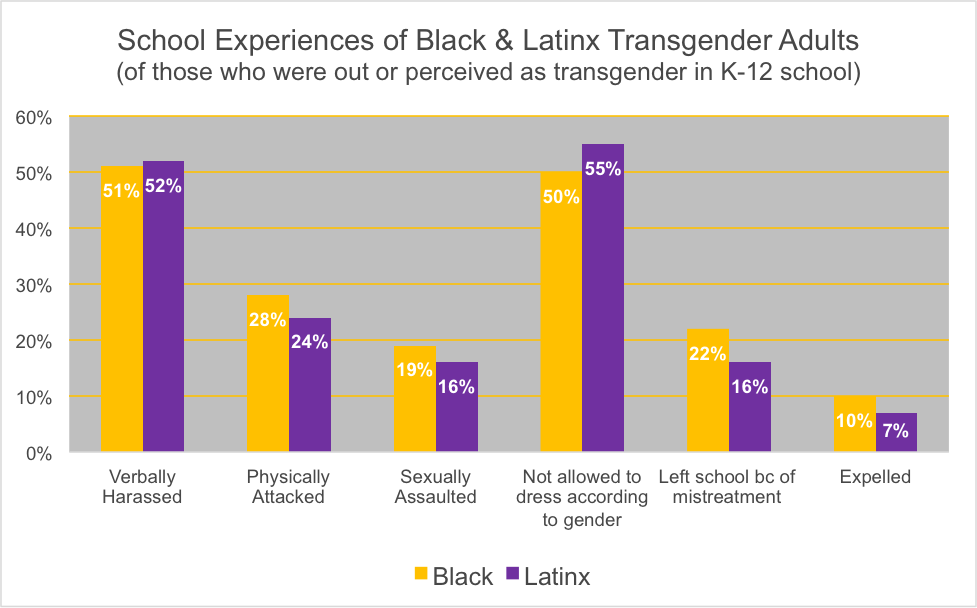What School Was Like for Black and Latinx Trans Adults – and How to Improve
GLSEN’s data has long demonstrated the hostile school environments that many transgender students face: including high rates of harassment and assault, denial of access to facilities, such as bathrooms and locker rooms, and being misgendered — including educators refusing to use students’ appropriate name and pronouns. The combination of peer victimization, discriminatory educator practices and policies, and lack of access to safe and appropriate educational spaces contributes to the elevated rates of negative outcomes experienced by transgender students, as compared to their cisgender peers. Transgender youth are more likely to miss school, drop out of school, face disciplinary sanctions, and, as a result, become involved in the juvenile justice system.
Two new reports from the National Center for Transgender Equality (NCTE) and their collaborating partners provide deeper insight into the experiences of transgender people in the educational system, specifically the experiences of Black and Latinx trans people in K-12 schools.
Using data from NCTE’s U.S. Transgender Survey, these reports provide retrospective data on what these transgender adults (ages 18 to 87) experienced in their K-12 school environments, and the statistics are jarring. Of those who were out as transgender at some point in their K-12 schooling, nearly three-quarters (74%) of both Black and Latinx transgender people reported experiencing some sort of mistreatment at school, including harassment so severe it caused them to leave that school. The bar chart below details percentages of Black and Latinx transgender people who were out as transgender or perceived by others as transgender and reported various negative school experiences during their time in K-12 schools.

These reports are from current adults, so it’s important to remember that while some of them were students more recently, many of them attended schools multiple years or even decades ago. Yet, GLSEN’s data on school climate for current trans middle/high school students demonstrates that victimization and discrimination are still very much a reality in our schools today, and that trans youth, and LGBTQ Black, Latinx, and multiracial youth are at greater risk for being pushed out of school.
Thankfully, we know what is needed to improve the outcomes for these youth. Resources including student clubs such as GSAs (Gay-Straight Alliances or Gender-Sexuality Alliances), anti-bullying policies that specifically protect gender identity and gender expression, and LGBTQ-inclusive curriculum have been demonstrated to improve the school experiences of trans youth and LGBTQ youth of color. In order to maximize the benefits for Black and Latinx transgender youth, these resources must be explicitly trans-inclusive and directly speak to LGBTQ youth of color.
In regards to specific policies, the GLSEN/NCTE model policy on supporting transgender and gender nonconforming students provides schools with best practices they can implement to improve access to education for transgender students and create a learning environment in which they can thrive.
Schools should also enact specific efforts to end unfair discipline policies and curb disparities in juvenile justice involvement for transgender students, particularly Black and Latinx transgender students. This should involve ceasing the use of zero-tolerance disciplinary policies and promoting restorative justice approaches designed to keep students in school.
Additionally, providing anti-bias training for school staff — including security personnel and school police — will help to help to create safer school environments for transgender students and reduce bias in the application of disciplinary and other school policies.
The results of the reports are jarring, but they provide important information about the needs of Black and Latinx transgender students that can be used to improve school policies and provide these students with an opportunity to learn without fear of violence or discrimination. For ways to continue working towards schools that are inclusive of these youth, see GLSEN’s resources for supporting trans students.
Sandy James, JD, MA, is the Research Director at the National Center for Transgender Equality, and Emily Greytak, PhD, is the Director of Research at GLSEN.
